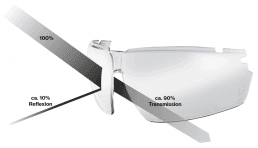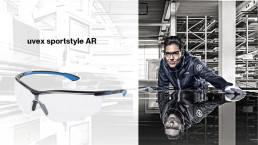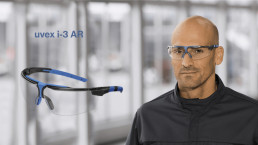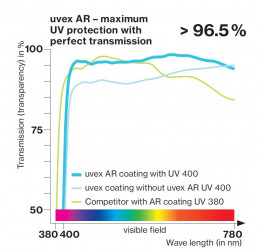Safety spectacle lenses are usually coated to prevent fogging and/or scratching. An anti-fog coating is especially important for high humidity environments or physically demanding work, such as in the paper or food industries. For work involving high dust exposure, for example on construction sites, an effective scratch-resistant coating is necessary so that dirty lenses do not become scratched when they are cleaned. This improves the comfort of the person wearing the safety spectacles, allowing them to concentrate to the best of their ability on the most important thing – their work.
But traditional coatings are not always best suited for specific workplace conditions. Sometimes wearers complain of distracting reflections and glare. This can significantly reduce wearer comfort and adversely affect concentration levels. Special AR coatings can solve this problem.
Traditional safety spectacles often use a colourless, polycarbonate lens (PC). In everyday working life, this type of plastic protects best against three risk categories:
- mechanical (fragments and particles)
- chemical (acids and other liquids)
- optical (UV rays and glare)
Additionally, PC can be formed into almost any lens shape using injection moulding. The lens can also be finished with an anti-fog or scratch-resistant coating, thereby increasing the wearer’s comfort. On average, a colourless PC lens has an average transmission (T) of around 90% of the visible light spectrum from 380 to 780 nanometres (see Figure 4 below). However, optical radiation can also be reflected (R) or absorbed (A). Figure 1 illustrates these physical effects. Subsequently, around 90% of light passes through the lens and into our eyes, while 10% (one in every ten rays of light) is reflected or absorbed by the lens (absorption does not apply for colourless PC lenses).

Percentage distribution of transmission and reflection of safety spectacle lens
Applications for anti-refelctive safety spectacle lenses
For most applications where safety spectacles are used, a transmission of 90% is completely sufficient to see well. Even residual reflections generally do not disturb the wearer or impair their comfort. However, in rare cases, specific workplaces or applications mean that workers are disturbed residual lens reflections and as a result their ability to work is restricted. For example, in quality control (bright lights all around in order to identify defects) or where there is a combination of natural sunlight and artificial light, disturbing lens reflections can occur. If rays of light enter the lens from behind or from the side, this reflects the surroundings on the lens, which distracts the person wearing the safety spectacles and restricts their vision through them.

uvex sportstyle AR (9193.838)
Anti-reflective lenses as standard?
However, when it comes to traditional, widely available prescription spectacles, anti-reflective or often even super anti-reflective lenses come as a standard option. This anti-reflective coating can be identified by the green-tinted residual reflections on the lens. However, when it comes to eye protection in the area of industrial health and safety, anti-reflective safety spectacles are more the exception than the norm. The added benefit of anti-reflective lenses is especially clear for people operating in specific work environments. uvex’s solution to this problem is the uvex supravision AR coating. Using a complex technical procedure, the safety spectacle lenses are processed to increase transmission and subsequently reduce reflections. The lens is coated with distinct, very thin layers via vapour deposition. This can increase transmission to as much as 97%. Consequently, disturbing lens reflections are less perceptible, increasing wearer comfort in the process.
uvex currently offers two models with uvex supravision AR coating in their safety spectacles range. The uvex sportstyle AR (9193.838 – see Figure 2 above) is above all characterised by its sporty, lightweight design. With an adjustable, soft nose piece, the spectacles can be further individually adapted to ensure comfort.
The uvex i-3 AR (9190.838 – see Figure 3 below) is ergonomically optimised with its particularly technical design: the ability to adjust the angle of the side arms enables individual adaptation to any face shape and an adjustable nose piece prevents the danger of the spectacles slipping. Additionally, the uvex Softflex zones on the side arms leave no pressure marks.

uvex i-3 AR (9190.838)
Technical data and features:
- UV protection up to 400nm (UV400)
- 2C-1.2 marking in accordance with EN 166/170
- Transmission: approximately 96.5% of the visible spectrum from 400 nm to 780 nm

Spectacle Lenses can be tinted to any kind of color for those people who want to wear sunglasses customized to power and Spectacle lenses Protect users from UV rays from the sun